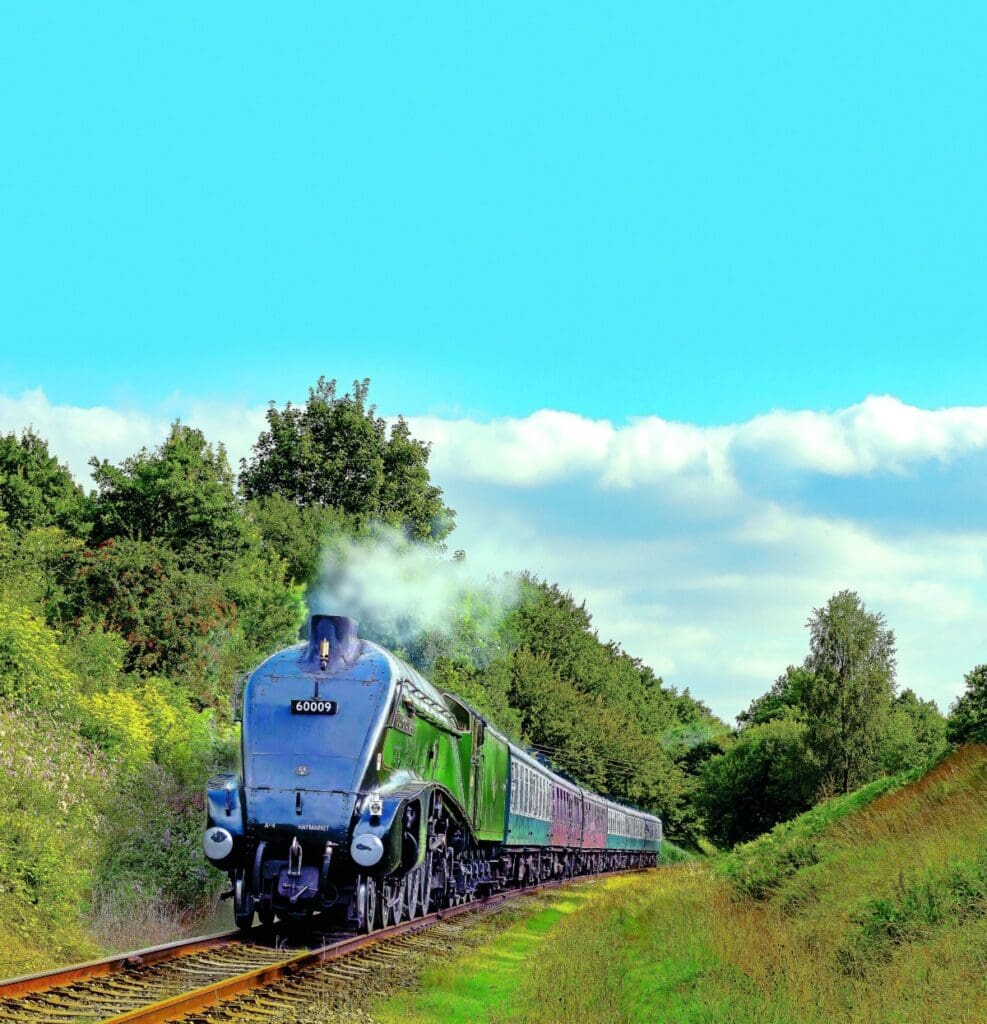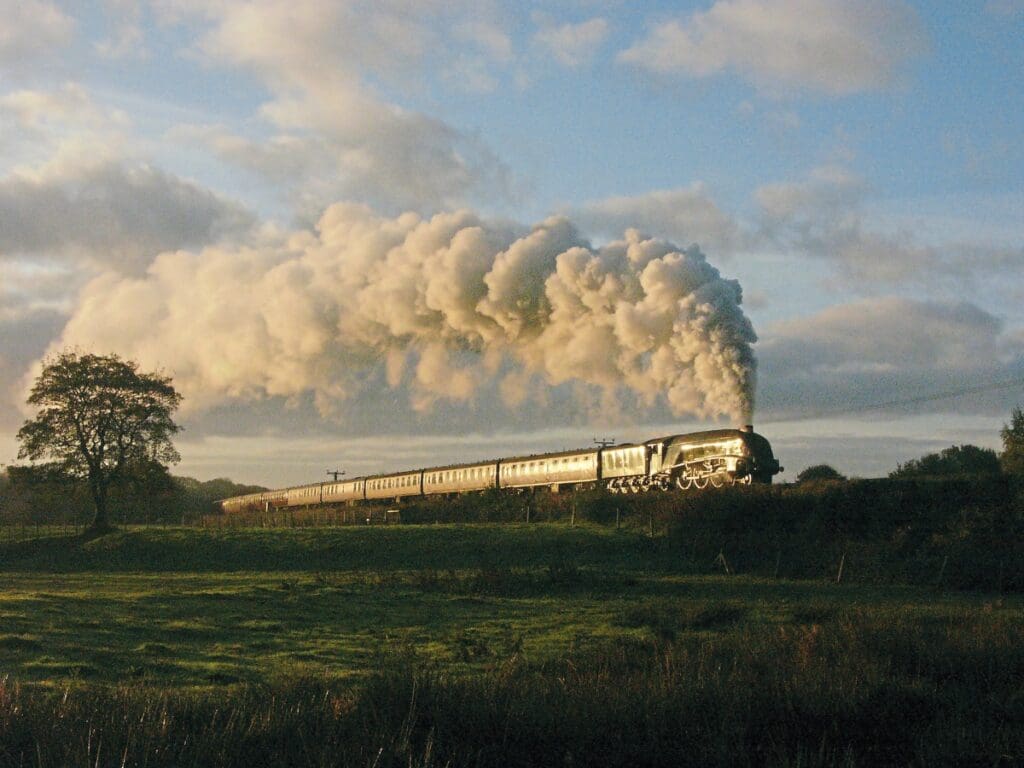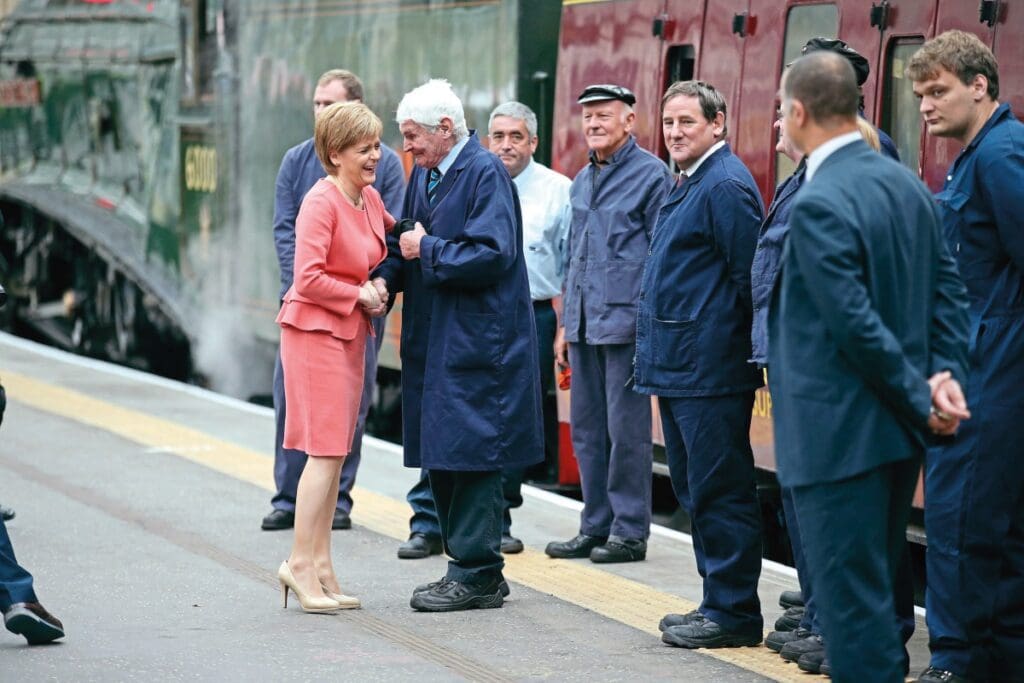
In a statement issued by the East Lancashire Railway on October 5, a spokesman said: “Unfortunately A4 No. 60009 Union of South Africa has formally been removed from service following the discovery of issues with its boiler tubes.
“Given the location of the tubes and the fact that the locomotive has only a short length of time – five months – on its current boiler certificate, a repair is not deemed viable.”
Not only did the streamlined A4 miss the line’s October 15-17 autumn gala, but it will also no longer star in a proposed farewell event at the end of the year – and it seems that the A4 has reached an earlier-than-scheduled end of the line in a notable career with the LNER, British Railways, and John Cameron, the man who saved it from the breaker’s torch.
Enjoy more Heritage Railway reading in the four-weekly magazine.
Click here to subscribe & save.
Many will claim that the Gresley A4s are arguably the most famous of steam locomotive classes – a statement giving rise to knowingly prompted smiles by Swindonians. However, it is true that the A4s gave rival LMS officials a run for their money in a 20th century ‘Race to the North’ as Euston and King’s Cross speeded up services to Scotland, the rivalry reaching its climax in the 1930s.
In 1935, the newly-introduced Silver Jubilee service from King’s Cross to Newcastle featured the first A4 No. 2509 Silver Link, hauling specially-designed carriages. The train, commemorating the Silver Jubilee year of King George V and Queen Mary, quickly became popular, with the A4s cutting journey times to a notable four hours.
A press demonstration run was made on September 27, 1935, for the impending service. The train, hauled by Silver Link, was accelerated to the point where the A4 achieved 112mph on its way to Grantham.
Such was the success of the Silver Jubilee that the LNER introduced the Coronation, which ran from King’s Cross to Edinburgh with only one stop en route. No. 4488 Union of South Africa entered service on June 29, 1937, the first of five engines nominated for the Coronation, carrying garter blue livery with red wheels and stainless steel lettering, numerals and trim, and bearing a ‘Commonwealth’ name.
Continuing the bird theme for the A4 names, the locomotive had previously been allocated Osprey on April 17, 1937, but was renamed by the time it was outshopped.
By now, the A4s were proving to be reliable and capable of high speeds. They steamed well and were popular with footplate crews. A total of 35 were built, the final batch forming the entire output of Doncaster between December 1936 and July 1938.
The competition between the LNER and LMS continued, reviving the old ‘Race to the North’ theme when the GNR had Stirling singles pitted against the LNWR Precedent class locomotives.
On June 28, 1937, the LMS hit back when Stanier’s Princess Coronation class No. 6220 Coronation set a new record of 114mph – famously racing into Crewe station and almost derailing as it rattled the crockery in the kitchen and restaurant cars. But on July 3, 1938, No. 4468 Mallard achieved 126mph, and that is another story…

During the Second World War, Union of South Africa was painted black and the L and R were removed from LNER as an economy measure. The garter blue livery with red and white lining was reapplied on February 21, 1947.
The locomotive was renumbered nine on January 12, 1946, and is still referred to colloquially on the lineside as Number Nine. It gained a stainless steel number nine at this stage.
BR express passenger blue livery was applied on August 4, 1949, followed by Brunswick green livery on October 2, 1952. It has worn this livery ever since.
The springbok plaque on the side of the locomotive was donated on April 12, 1954, by a Bloemfontein newspaper proprietor.
Union of South Africa was first allocated to Edinburgh Haymarket (64B) shed, remaining there until being transferred as one of six A4s to Aberdeen Ferryhill in May 1962, as replacements for newly-introduced North British Type 2s (later Class 21), which were unreliable. There, the A4s were used to speed up Aberdeen-Glasgow services.
No. 60009 had a double chimney fitted on November 18, 1958, 20 years after Mallard was similarly equipped. As safety requirements were tightened after the Harrow rail crash, Automatic Warning Systems were fitted to all locomotives and No. 60009 received its apparatus on February 17, 1960, when a Smith-Stone type speed recorder was also fitted.
No. 60009 has been fitted with 14 boilers in its lifetime, the last being No. 29337 from No. 60023 Golden Eagle on November 6, 1963. It has had five tenders of two different types. The first was a 1928-pattern streamlined corridor tender, a rebuild of a tender fitted to a Class A1 or A3 Pacific and streamlined for fitting to an A4. It was later changed for a new-build streamlined corridor tender from 1948-63. Currently, Union of South Africa is fitted with a 1928-pattern streamlined corridor tender, allowing the crew to be changed while the locomotive is hauling passenger trains. This tender was originally fitted to the Gresley experimental high-pressure No. 10000.
Union of South Africa hauled the last booked steam-hauled train from King’s Cross on October 24, 1964. It was 20 minutes late through Grantham due to a broken rail at High Dyke.
No. 60009 was also the last locomotive to be overhauled at Doncaster while in service. It was withdrawn from traffic on June 1, 1966, after which it was sold into preservation and purchased that August – chosen because it was the latest of the A4s to be overhauled and, more importantly, John Cameron said, the Ferryhill foreman fitter, the late Jock Tosh reckoned it was the best of the A4s still running.
During a recent conversation, John laughingly added that it was in even better condition when Jock and his boys had finished with the engine before releasing it to its new owner…
From Ferryhill, the 4-6-2 was moved to Thornton depot in Fife, then travelled on two miles to the closed East Fife Central goods line which was conveniently situated within the boundary of one of John’s farms. In 1967, he built a 75ft shed to house his purchase and relaid three-quarters of a mile of track; one pair of points and one line leading into the shed, the other to the old loading bank which was modified to serve as a platform.
That summer, No. 60009 gave footplate rides, and every summer Sunday afternoon from 1968, No. 60009 was steamed over what became known as the Lochty Private Railway, running on the line for the benefit of the many photographers and public spectators, the A4 hauling one carriage, former LNER ‘Beavertail’ observation coach No. 1719.
According to John, the ballast consisted of mainly ash, which resulted in the 1.5-mile track moving dramatically when the engine passed over sections. “How it never came off the road, I’ll never know,” he said.
In 1970 the track was extended and a second carriage added. The 1972 season saw the number of passengers carried breaking 7000 for the first time.

Towards the end of that year, following the relaxation of the post-1968 BR steam ban as described last issue, the possibility of moving No. 60009 back to BR was considered.
In January 1973, two routes were allocated in Scotland for the running of steam railtours. Since No. 60009 had worked the last steam special in Scotland in 1967, it was appropriate that it hauled the first steam trip in the Big Country after the ban was lifted.
That landmark tour took place on May 5, 1973, and No. 60009, which had been moved to Ladybank by road to be rerailed on the national network, showed it was still capable of handling nine coaches at speeds of up to 60mph over the twisty Edinburgh to Dundee main line.
From Ladybank, No. 60009 was moved on to Kirkcaldy, where it was housed in a goods shed. It was later taken to Markinch – and another former goods shed – where it remained until 1994.
At the end of the 1992 summer season, steadily rising costs brought about the demise of the Lochty Private Railway. That same year, the Kingdom of Fife Railway Preservation Society was formed to take over the remaining collection at the line and, in 1994, moved the last of the collection out. Today, the rolling stock is based at Kirkland yard in Leven.
Due to international public disgust at the continuation of apartheid during the 1980s and early 1990s, No. 60009 carried Osprey nameplates during this time.
With main line running very much at the forefront, in May 1994 the locomotive left Markinch for the last time on a low loader bound for the Severn Valley Railway, where repairs were to be undertaken in the Bridgnorth workshops. The route took it over the Forth Road Bridge, and in doing so it became the only steam locomotive to cross both the adjacent Forth road and rail bridges.
Once completed, the A4 remained on the SVR for so long that many considered it to be part of that line’s fleet.
On October 29, 1994, appropriately, No. 60009 hauled the first steam train out of King’s Cross for 30 years under the banner of the Elizabethan, making more East Coast Main Line history – or rather, carrying on from where it left off in 1964. The train ran to Peterborough and on to Wansford on the Nene Valley Railway, repeating the excursion the following day. Tickets sold out fast, and the usual 60mph speed limit for steam was lifted to allow for a 75mph limit.
No. 60009 was fitted with on-train monitoring recorder equipment in early 2007. That year, No. 60009 returned to Scotland, where it was hired by the Railway Touring Company and worked a leg of the promoter’s ‘Great Britain’ nine-day tour, the engine being based at Thornton Junction. The trip’s highlight was that the A4 and Gresley K4 2-6-0 No. 61994 The Great Marquess worked double-headed.
Between July 28, 2007 and when its boiler ticket expired in 2010, No. 60009 worked 25 trips for RTC. It featured in the North Yorkshire Moors Railway’s LNER Festival 2008, along with No. 60007 Sir Nigel Gresley and No. 60019 Bittern – the first time that all three were together in the heritage era.
Union of South Africa’s most recent overhaul, at pop mogul Pete Waterman’s LNWR workshops at the Crewe Heritage Centre, beginning in 2010, was said to have cost almost £1 million. It returned to the main line on July 22, 2012, to be hired by West Coast Railways; it was regularly seen on the ‘Scarborough Spa Express’ from York travelling via Knaresborough, Harrogate and Leeds.
In 2013, No. 60009 took part in one of the definitive showpiece events in the history of UK railway preservation. Organised by former National Railway Museum head Steve Davies, the Great Gathering saw all six surviving A4s at the York venue to mark the 75th anniversary of Mallard’s world speed record run in July 2013. Mallard, Bittern, Sir Nigel Gresley and No. 60009 were joined by exiled No. 60008 Dwight D. Eisenhower and No. 60010 Dominion of Canada. Steve negotiated a ground-breaking deal with the latter’s two North American museum homes to borrow and cosmetically restore them. Three Great Gatherings were held at the NRM that year. The Great Goodbye was held at the Locomotion Museum in Shildon the following February before Nos. 60008 and 60010 were shipped home.
No. 60009 has hauled charter trains for many promoters, especially the Railway Touring Company, and also the Scottish Railway Preservation Society, UK Railtours, Pathfinder Tours, and the former Past-Time Rail and Flying Scotsman Services, giving magnificent service while accumulating the highest mileage of any A4.
Wednesday, September 9, 2015 was a great historic occasion on several fronts when The Queen, accompanied by The Duke of Edinburgh, officially opened the new
£294 million Borders Railway, marking the partial rolling back of one of the biggest closures of the post-Beeching era – that of the Waverley Route from Edinburgh to Carlisle.
Secondly, it was on that day that The Queen officially became the longest-reigning monarch in more than a millennium of British history; at 5.30pm she overtook Victoria’s record of 23,226 days, 16 hours and roughly 30 minutes.
Thirdly, the day was a shining moment for the UK heritage sector. None other than Union of South Africa hauled the royal opening special – comprising BR Mk.1 stock supplied by the Scottish Railway Preservation Society and staffed by its volunteers – over the 30½-mile line from Edinburgh Waverley to Tweedbank.
Stealing the show at Waverley before The Queen’s arrival was John Cameron’s No. 60009, the booked appearance of which was thrown into doubt after it ran a hot axlebox in south Devon in August. It was speculated that sister Sir Nigel Gresley or Peppercorn A1 Pacific No. 60163 Tornado might deputise, but repair work carried out in a race against time ensured that Number Nine would claim its place in history. Prior to the arrival of the royal party, Scotland’s First Minister Nicola Sturgeon climbed into the cab of the locomotive, which pulled into Waverley shortly after 9am, driven by Steve Hanczar, the other two members of the DB Schenker footplate crew being Jim Smith and Tony Jones.

Between 2015 and 2020, Union of South Africa was the only A4 operational with a valid main line certificate; No. 60007 was withdrawn for overhaul on September 20, 2015, and Bittern operated until the end of 2015 at the Mid-Hants Railway, when it was withdrawn for its overhaul at Crewe.
Union of South Africa’s ticket was extended for a year, the A4 making its last trip for RTC with the ‘Yorkshireman’ on March 7, 2020, starting out from Ealing Broadway and running via Finsbury Park to York.
Due to move onto the East Lancashire Railway, the 4-6-2 was held up because of the onset of Covid-19, and was eventually taken to Bury behind a diesel.
However, Union of South Africa was fated to never leave East Lancashire metals under its own steam or run on the main line again.
No A4s are currently operating, but Sir Nigel Gresley is due to return to service in early 2022 following the completion of a major overhaul.
Advert
 Enjoy more Heritage Railway reading in the four-weekly magazine. Click here to subscribe.
Enjoy more Heritage Railway reading in the four-weekly magazine. Click here to subscribe.



